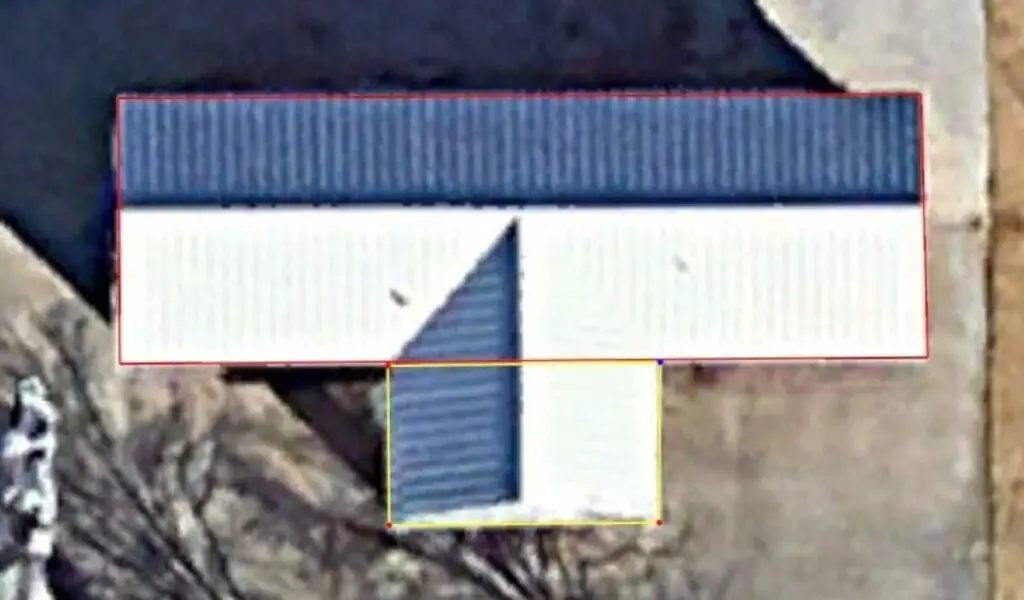I participate in the Amazon affiliate program and may earn commissions from purchases made through links on this page.
Also see: Roof Cost Calculator
Table of Contents

Introduction
This Roof Area Calculator helps you accurately determine the surface area of a roof, whether you’re a professional in the construction industry or a homeowner planning a roofing project.
You enter the width, length, and slope of each roof section, and the calculator computes the footprint area of the roof section, the roof pitch multiplier that applies for the given slope, and the actual surface area of the roof section.
You can get the dimensions of your roof sections by physically measuring the building (include roof overhangs in your measurements, not just the exterior wall dimensions), or you may be able to get usefully accurate measurements on Google Earth (this works much better for flat commercial roofs than for smaller pitched residential roofs). For help with this, see my article on how to measure a roof with Google Earth.
If you’re not sure what the slope of your roof is and you want to measure it, in either degrees or standard roof pitch (X:12), I recommend this slope finder on Amazon. It’s very inexpensive and very accurate. I also made an online roof pitch visualizer tool that you can use. You can see it here.
If your building is in the shape of a simple square or rectangle, you’ll only need to enter the width, length, and slope for the whole building, but the calculator also allows you to add the dimensions for multiple roof sections and then calculate their combined total area, which is useful for more complex building shapes.
This calculator works for gable roofs, hip roofs, basically any roof with a uniform pitch. Roof sections with different pitches should be calculated separately and then added together.
You can select feet or meters for your unit of measurement, and you can enter your roof slope in either standard roof pitch (X-in-12) or degrees.
Roof Surface Area Calculator
Gable Roofs and Hip Roofs Have the Same Area
Question: Do gable roofs and hip roofs that cover the same footprint and have the same pitch have the same surface area?
Answer: Yes. It feels counterintuitive because a hip roof slopes down on all four sides while a gable roof has vertical gable ends. That difference does not change the total surface area of the combined roof planes when the footprint and pitch are the same.
(Related, but not relevant here: Gable roofs and hip roofs do produce different attic volumes.)
How to think about it:
- One roof pitch multiplier applies to all roof planes with the same pitch. For a uniform pitch with angle θ, the roof surface area simply equals the horizontal footprint area multiplied by the roof pitch multiplier, which is sec θ.
Roof Surface Area = Footprint Area × sec θ - A gable roof has two large main planes which are roof areas, but it also has two gable ends, which are wall areas, not roof areas. A hip roof has four smaller planes, all of which are roof areas, and no wall areas. If the footprint is the same and every plane has the same pitch, the total horizontal plan area covered by both the gable roof and the hip roof is still the same rectangle. Adding hips and shortening the ridge only changes how many roof planes cover that rectangle, not the total plan area (or the total area of the roof planes).
- Since the total roof surface area is simply Footprint Area × Roof Pitch Multiplier, it doesn’t matter whether it’s a gable roof or a hip roof if they have the same slope.
- Ridges, hips, and valleys are lines where planes meet. Lines have length, not area. They affect layout and the roofing contractor’s waste factor, but they do not change surface area.
Example:
- Footprint: 30 ft × 50 ft = 1,500 ft²
- Pitch: 6 in 12, so the multiplier is √(1 + (6/12)²) = √1.25 ≈ 1.1180
- Roof surface area: 1,500 × 1.1180 ≈ 1,677 ft²
That roof can be either a gable roof or a hip roof. As long as the footprint and the pitch stay the same, you still get 1,677 ft² of roof surface area.
Assumptions:
- Same rectangular footprint
- Same pitch on every plane
- Counting only the roof planes, not any vertical wall surfaces
More Roof Calculators
These calculators provide more detailed measurement information, including surface area, but also other key dimensions specific to that roof type, such as hip length and attic volume. Some of them cover roof types that don’t have flat roof planes or uniform pitches.
- Barrel Roof Calculator: Area, Arc Length, Volume, and More
- Conical Roof Surface Area Calculator and Math
- Dome Roof Area Calculators (Spherical, Ellipsoid, Onion)
- Gable Roof Calculator: Area, Slope, Volume, Rakes & More
- Hip Roof Calculator: Area, Slope, Volume, Ridge, Hips & More
- Pyramid Roof Calculator: Area, Slope, Hips & More
- Saltbox Roof Calculator: Area, Slopes, Volume, Rakes & More

